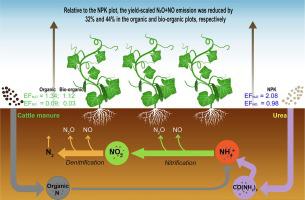Our official English website, www.x-mol.net, welcomes your feedback! (Note: you will need to create a separate account there.)
Soil N-oxide emissions decrease from intensive greenhouse vegetable fields by substituting synthetic N fertilizer with organic and bio-organic fertilizers
Geoderma ( IF 6.1 ) Pub Date : 2021-02-01 , DOI: 10.1016/j.geoderma.2020.114730 Yajun Geng , Jinyang Wang , Zhirong Sun , Cheng Ji , Mengyuan Huang , Yihe Zhang , Pinshang Xu , Shuqing Li , Mark Pawlett , Jianwen Zou
Geoderma ( IF 6.1 ) Pub Date : 2021-02-01 , DOI: 10.1016/j.geoderma.2020.114730 Yajun Geng , Jinyang Wang , Zhirong Sun , Cheng Ji , Mengyuan Huang , Yihe Zhang , Pinshang Xu , Shuqing Li , Mark Pawlett , Jianwen Zou

|
Abstract In order to reduce soil and environmental quality degradation associated with the use of synthetic nitrogen (N), substituting chemical fertilizer with organic or bio-organic fertilizer has become an increasingly popular option. However, components of this fertilizer strategy related to mitigation of soil N-oxide emissions and maintenance of crop yield remain uncertain. Here, we evaluated the effects of three different fertilizer strategies, with equal amounts of N, on nitrous oxide (N2O) and nitric oxide (NO) emissions, vegetable yield, and yield-scaled N2O and NO emissions under three consecutive cucumber growing seasons. The three treatments were chemical fertilizer (NPK, urea), organic fertilizer (O, composted cattle manure), and bio-organic fertilizer (O + T, O combined with Trichoderma.spp). Results showed that the NPK plot had the highest area-scaled emissions of N2O (13.1 ± 0.48 kg N ha−1 yr−1) and NO (5.01 ± 0.34 kg N ha−1 yr−1), which were 1.3–1.4 and 3.1–3.7 times greater than the O and O + T plots, respectively. The annual direct emission factors for N2O and NO were 2.08% and 0.92% for the NPK plot, which declined to 1.34% and 0.09% in the O plot, and 1.12% and 0.03% in the O + T plot, respectively. The annual vegetable yield was 117 ± 2.9 t ha−1 for NPK plot and 122 ± 2.0 t ha−1 for O + T plot, which was higher than 111 ± 1.7 t ha−1 for O plot. The yield-scaled N2O + NO emissions differed significantly with fertilization treatment, with the lowest value observed in the O + T plot. We attributed the lower soil N-oxide emissions following organic fertilizer application to the slow release of available N and enhanced denitrification caused by the increase of soil dissolved organic carbon and pH. Compared with the use of organic fertilizer alone, the addition of Trichoderma.spp significantly increased the potential denitrification rate but decreased N2O emissions, which may have promoted the reduction of N2O to N2. Therefore, our results suggest that adopting composted organic fertilizer mixtures with microbial inoculants could be a win-win practice to mitigate gaseous N losses and simultaneously improve crop yield in intensively managed vegetable cropping systems.
中文翻译:

有机和生物有机肥替代合成氮肥减少集约化温室蔬菜地土壤氮氧化物排放
摘要 为了减少与合成氮(N)使用相关的土壤和环境质量退化,以有机或生物有机肥替代化肥已成为越来越受欢迎的选择。然而,与减少土壤氮氧化物排放和维持作物产量相关的施肥策略的组成部分仍然不确定。在这里,我们评估了三种不同的施肥策略,在三个连续的黄瓜生长季节下,等量的 N 对一氧化二氮 (N2O) 和一氧化氮 (NO) 排放、蔬菜产量以及按产量衡量的 N2O 和 NO 排放的影响。三个处理分别为化肥(NPK、尿素)、有机肥(O、堆肥牛粪)和生物有机肥(O+T、O与木霉属.spp)。结果表明,NPK 图具有最高的 N2O (13.1 ± 0.48 kg N ha-1 yr-1) 和 NO (5.01 ± 0.34 kg N ha-1 yr-1) 的面积尺度排放,分别为 1.3-1.4 和分别比 O 和 O + T 图大 3.1–3.7 倍。N2O 和 NO 的年直接排放因子在 NPK 地块分别为 2.08%和 0.92%,在 O 地块中分别下降到 1.34%和 0.09%,在 O+T 地块中分别下降到 1.12%和 0.03%。NPK 地的蔬菜年产量为 117±2.9 t ha-1,O + T 地为 122±2.0 t ha-1,高于 O 地的 111±1.7 t ha-1。以产量为单位的 N2O + NO 排放与施肥处理显着不同,在 O + T 图中观察到的最低值。我们将有机肥施用后土壤氮氧化物排放量降低归因于有效氮的缓慢释放和土壤溶解有机碳和 pH 值增加引起的反硝化作用增强。与单独使用有机肥相比,Trichoderma.spp 的添加显着提高了潜在反硝化率,但降低了 N2O 排放,这可能促进了 N2O 向 N2 的还原。因此,我们的结果表明,在集约化管理的蔬菜种植系统中,采用带有微生物接种剂的堆肥有机肥料混合物可能是一种双赢的做法,可以减轻气态氮的损失,同时提高作物产量。spp 显着提高了潜在的反硝化率,但减少了 N2O 排放,这可能促进了 N2O 还原为 N2。因此,我们的结果表明,在集约化管理的蔬菜种植系统中,采用带有微生物接种剂的堆肥有机肥混合物可能是一种双赢的做法,可以减轻气态氮的损失,同时提高作物产量。spp 显着提高了潜在的反硝化率,但减少了 N2O 排放,这可能促进了 N2O 还原为 N2。因此,我们的结果表明,在集约化管理的蔬菜种植系统中,采用带有微生物接种剂的堆肥有机肥混合物可能是一种双赢的做法,可以减轻气态氮的损失,同时提高作物产量。
更新日期:2021-02-01
中文翻译:

有机和生物有机肥替代合成氮肥减少集约化温室蔬菜地土壤氮氧化物排放
摘要 为了减少与合成氮(N)使用相关的土壤和环境质量退化,以有机或生物有机肥替代化肥已成为越来越受欢迎的选择。然而,与减少土壤氮氧化物排放和维持作物产量相关的施肥策略的组成部分仍然不确定。在这里,我们评估了三种不同的施肥策略,在三个连续的黄瓜生长季节下,等量的 N 对一氧化二氮 (N2O) 和一氧化氮 (NO) 排放、蔬菜产量以及按产量衡量的 N2O 和 NO 排放的影响。三个处理分别为化肥(NPK、尿素)、有机肥(O、堆肥牛粪)和生物有机肥(O+T、O与木霉属.spp)。结果表明,NPK 图具有最高的 N2O (13.1 ± 0.48 kg N ha-1 yr-1) 和 NO (5.01 ± 0.34 kg N ha-1 yr-1) 的面积尺度排放,分别为 1.3-1.4 和分别比 O 和 O + T 图大 3.1–3.7 倍。N2O 和 NO 的年直接排放因子在 NPK 地块分别为 2.08%和 0.92%,在 O 地块中分别下降到 1.34%和 0.09%,在 O+T 地块中分别下降到 1.12%和 0.03%。NPK 地的蔬菜年产量为 117±2.9 t ha-1,O + T 地为 122±2.0 t ha-1,高于 O 地的 111±1.7 t ha-1。以产量为单位的 N2O + NO 排放与施肥处理显着不同,在 O + T 图中观察到的最低值。我们将有机肥施用后土壤氮氧化物排放量降低归因于有效氮的缓慢释放和土壤溶解有机碳和 pH 值增加引起的反硝化作用增强。与单独使用有机肥相比,Trichoderma.spp 的添加显着提高了潜在反硝化率,但降低了 N2O 排放,这可能促进了 N2O 向 N2 的还原。因此,我们的结果表明,在集约化管理的蔬菜种植系统中,采用带有微生物接种剂的堆肥有机肥料混合物可能是一种双赢的做法,可以减轻气态氮的损失,同时提高作物产量。spp 显着提高了潜在的反硝化率,但减少了 N2O 排放,这可能促进了 N2O 还原为 N2。因此,我们的结果表明,在集约化管理的蔬菜种植系统中,采用带有微生物接种剂的堆肥有机肥混合物可能是一种双赢的做法,可以减轻气态氮的损失,同时提高作物产量。spp 显着提高了潜在的反硝化率,但减少了 N2O 排放,这可能促进了 N2O 还原为 N2。因此,我们的结果表明,在集约化管理的蔬菜种植系统中,采用带有微生物接种剂的堆肥有机肥混合物可能是一种双赢的做法,可以减轻气态氮的损失,同时提高作物产量。


























 京公网安备 11010802027423号
京公网安备 11010802027423号